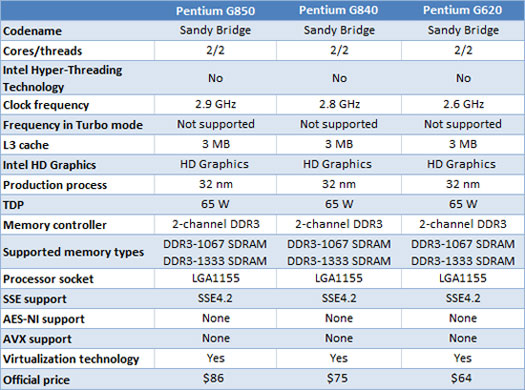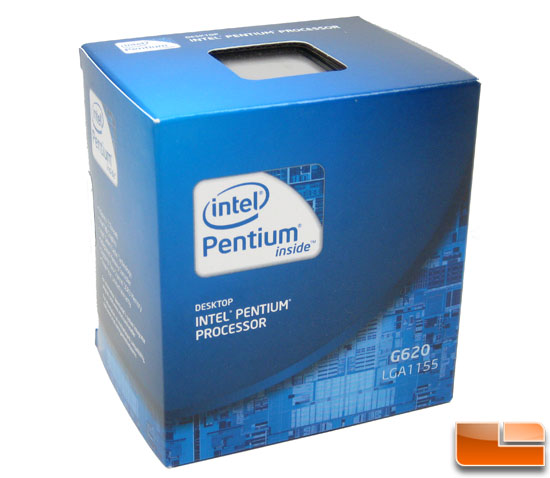Intel Pentium G620 Sandy Bridge 2.6GHz CPU Review
Intel Pentium G620 Processor Review
Did you know that on May 22, 2011 that Intel released the companies first Pentium processors that utilize the Intel 32nm Sandy Bridge architecture? The Intel Pentium processor family is comprised of three new SKUs, called the G620, G840 and G850. The Pentium G620, G840 and G850 CPUs run at 2.6GHz, 2.8GHz and 2.9GHz with current street pricing on these processors being $73.87, $88.52 and $95.38 respectively.

The Intel Pentium G620, G840 and G850 are all 32nm dual-core processors
rated at 65W TDP with 3MB of level 3 cache,
an integrated DDR3 memory controller, PCI Express 2.0 interface,
Direct Media Interface 2.0, and Intel HD Graphics 2000. The Intel HD
Graphics 2000 GPU has a base clock speed of 850MHz, but it is dynamic
and can increase up to 1100MHz when a graphics intensive task is called
upon. We’ve done several reviews on this GPU before and know that it is
up for basic HD tasks, but will fall short when it comes to mainstream
game titles. All of the Intel Pentium Processors are multiplier is
locked, so if you wanted to overclock one of these processors they only
way you can do so, is by increase the base clock frequency.
Since these are entry level Intel Pentium series CPUs they lack features that the Intel Core i3/i5/i7 Sandy Bridge processors have. For starters these three Pentium processors have the anemic Intel HD Graphics 2000 GPU and come without Hyper-Threading, Turbo Boost and both AES-NI, AVX and Intel Quick Sync Video have been disabled. As you can tell these processors are aimed at low-budget or entry level desktop systems and with the economy across the world being in flux the past several years these budget minded processors should be popular now that they have been released.

The model that we will be looking at today is the Intel Pentium Processor G620, which is the lowest cost ‘Sandy Bridge’ CPU on the market today. This processor has a tray price of just $64.00 with an actual street price of $73.87 shipped. The lowest cost Intel Core i3 processor based on the Sandy Bridge architecture is the Intel Core i3-2100 at $121.21 shipped, so as you can see the entry level Pentium processor is nearly half the price of it’s bigger and more powerful brother. Our goal for this review is to take the Intel Pentium Processor G620 and see how it’s 2.60GHz clock frequency and two cores can do against several other Intel processors like the Core i3-2105, Core i3-2120 and Core i7-2600K. We’ll also be tossing the AMD ‘Llano’ A8-3850 and A6-3650 into the mix to see how those processors fare as well.
Intel Pentium Processor G620 Specifications:
- Model #: BX80623G620
- S-spec: SR05R
- Launch Date: Q2’11
- Processor Number: G620
- Supported Socket: LGA1155
- # of Cores: 2
- # of Threads: 2
- Clock Speed: 2.60 GHz
- Intel Smart Cache: 3 MB
- Bus/Core Ratio: 26
- Instruction Set: 64-bit
- Instruction Set Extensions: SSE4.1/4.2
- Turbo Core: No
- Hyper-Threading Technology: No
- Lithography: 32 nm
- Processor Graphics: Intel HD Graphics
- Graphics Base Frequency: 850MHz
- Graphics Max Dynamic Frequency: 1100MHz
- Max TDP: 65 W
- Recommended Channel Price: $64.00

Since our review sample it the retail box Pentium G620 (part number BX80623G620) the processor comes with a CPU cooler, case sticker and a three year limited warranty. If you buy a tray processor you do not get the Heat Sink Fan (HSF) combo or the longer warranty.

As you can see this Intel Pentium Processor G620 is not an Engineering Sample processor and batch number of 3118B201. You can also see the S-Spec number SR05R on the integrated heat spreader (IHS) and that it was made in the country of Costa Rica.

The Intel Core i3-2120 processor is designed for socket H2 or LGA1155 platforms and has a slightly different arrangement of resistors on the bottom of the processor compared to some of the other Sandy Bridge processors since some use Intel HD Graphics 2000 and others use Intel HD Graphics 3000 graphics. In the image above you can see the difference between the Intel Pentium G620 with Intel HD Graphics 2000 and the Intel Core i3-2105 and Core i7-2600K that both use Intel HD Graphics 3000. If you want to use Intel Processor Graphics (PG) of the CPU you need to use a motherboard with the H67, or Z68 chipset that has video outputs and not the P67 based motherboards that don’t support PG. You can always add in a discrete graphics card if you want improved graphics performance.

Comments are closed.